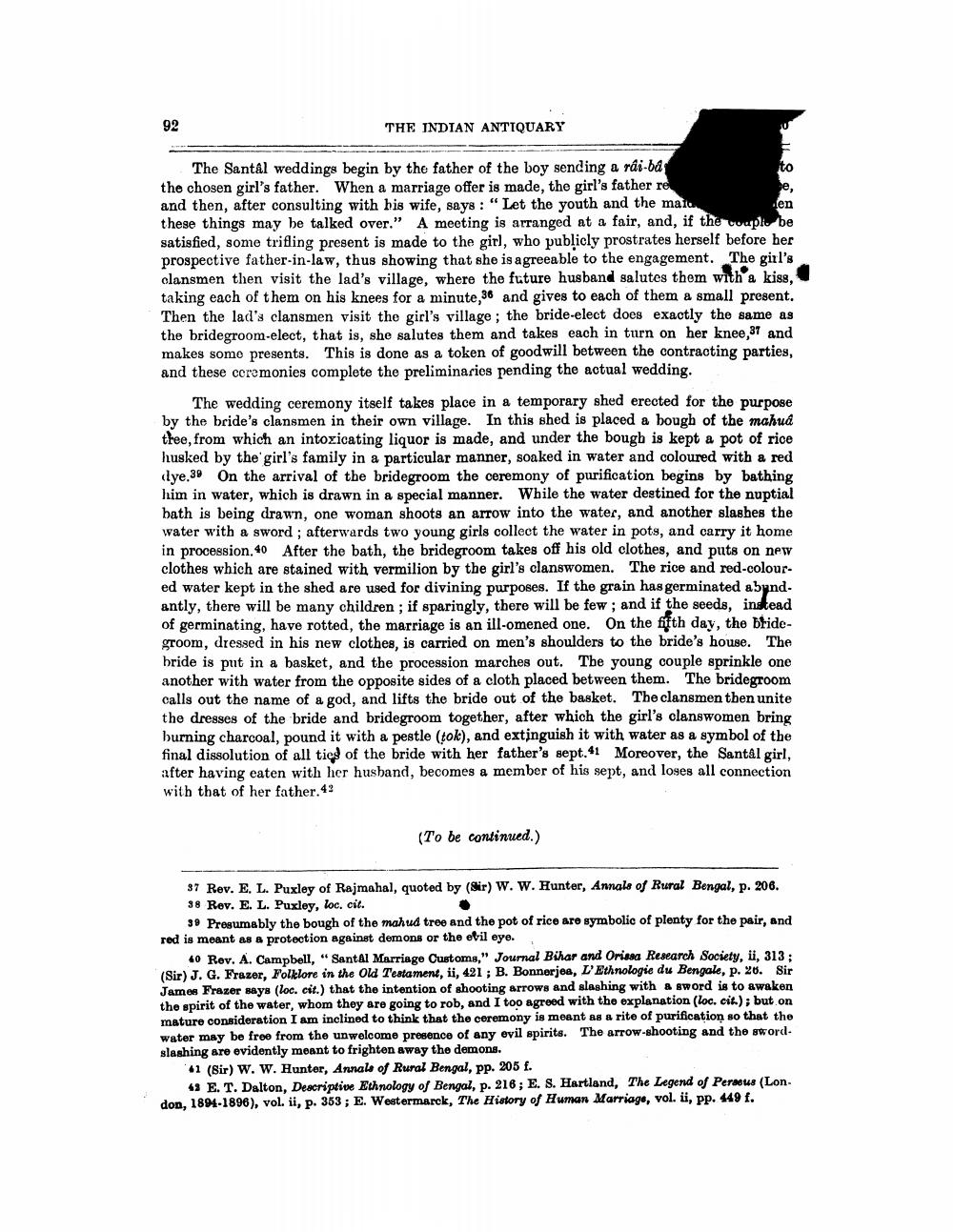________________
92
THE INDIAN ANTIQUARY
to
The Santal weddings begin by the father of the boy sending a rai-ba
e,
en
the chosen girl's father. When a marriage offer is made, the girl's father re and then, after consulting with his wife, says: "Let the youth and the mai these things may be talked over." A meeting is arranged at a fair, and, if the couple be satisfied, some trifling present is made to the girl, who publicly prostrates herself before her prospective father-in-law, thus showing that she is agreeable to the engagement. The girl's clansmen then visit the lad's village, where the future husband salutes them with a kiss," taking each of them on his knees for a minute,36 and gives to each of them a small present. Then the lad's clansmen visit the girl's village; the bride-elect does exactly the same as the bridegroom-elect, that is, she salutes them and takes each in turn on her knee,37 and makes some presents. This is done as a token of goodwill between the contracting parties, and these ceremonies complete the preliminaries pending the actual wedding.
The wedding ceremony itself takes place in a temporary shed erected for the purpose by the bride's clansmen in their own village. In this shed is placed a bough of the mahud thee, from which an intoxicating liquor is made, and under the bough is kept a pot of rice husked by the girl's family in a particular manner, soaked in water and coloured with a red dye.39 On the arrival of the bridegroom the ceremony of purification begins by bathing him in water, which is drawn in a special manner. While the water destined for the nuptial bath is being drawn, one woman shoots an arrow into the water, and another slashes the water with a sword; afterwards two young girls collect the water in pots, and carry it home in procession. 40 After the bath, the bridegroom takes off his old clothes, and puts on new clothes which are stained with vermilion by the girl's clanswomen. The rice and red-coloured water kept in the shed are used for divining purposes. If the grain has germinated abundantly, there will be many children; if sparingly, there will be few; and if the seeds, instead of germinating, have rotted, the marriage is an ill-omened one. On the fifth day, the bridegroom, dressed in his new clothes, is carried on men's shoulders to the bride's house. The bride is put in a basket, and the procession marches out. The young couple sprinkle one another with water from the opposite sides of a cloth placed between them. The bridegroom calls out the name of a god, and lifts the bride out of the basket. The clansmen then unite the dresses of the bride and bridegroom together, after which the girl's clanswomen bring burning charcoal, pound it with a pestle (tok), and extinguish it with water as a symbol of the final dissolution of all ties of the bride with her father's sept.41 Moreover, the Santal girl, after having eaten with her husband, becomes a member of his sept, and loses all connection with that of her father.42
(To be continued.)
37 Rev. E. L. Puxley of Rajmahal, quoted by (Sir) W. W. Hunter, Annals of Rural Bengal, p. 206. 38 Rev. E. L. Puxley, loc. cit.
39 Presumably the bough of the mahud tree and the pot of rice are symbolic of plenty for the pair, and red is meant as a protection against demons or the evil eye.
40 Rev. A. Campbell, "Santal Marriage Customs," Journal Bihar and Orissa Research Society, ii, 313; (Sir) J. G. Frazer, Folklore in the Old Testament, ii, 421; B. Bonnerjea, L'Ethnologie du Bengale, p. 26. Sir James Frazer says (loc. cit.) that the intention of shooting arrows and slashing with a sword is to awaken the spirit of the water, whom they are going to rob, and I too agreed with the explanation (loc. cit.); but on mature consideration I am inclined to think that the ceremony is meant as a rite of purification so that the water may be free from the unwelcome presence of any evil spirits. The arrow-shooting and the sword. slashing are evidently meant to frighten away the demons.
41 (Sir) W. W. Hunter, Annals of Rural Bengal, pp. 205 f.
42 E. T. Dalton, Descriptive Ethnology of Bengal, p. 216; E. S. Hartland, The Legend of Perseus (London, 1894-1896), vol. ii, p. 353; E. Westermarck, The History of Human Marriage, vol. ii, pp. 449 f.




